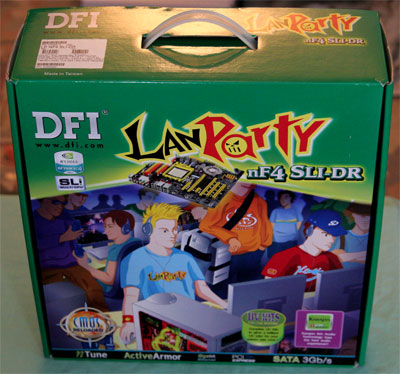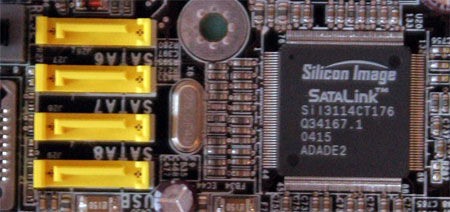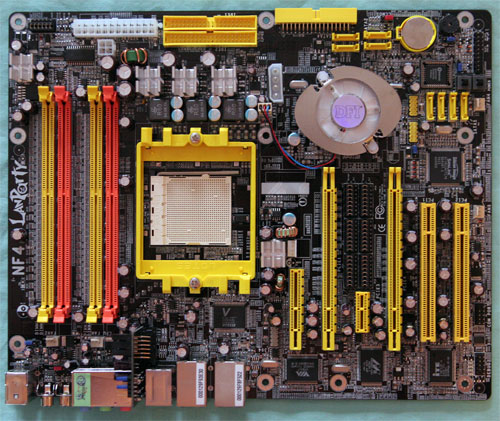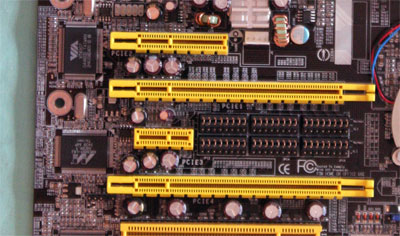nForce4 SLI Roundup: Painful and Rewarding
by Wesley Fink on February 28, 2005 7:00 AM EST- Posted in
- Motherboards
DFI LANParty nF4 SLI-DR: Features and Layout
| Specification | DFI LANParty nF4 SLI-DR |
| CPU Interface | Socket 939 Athlon 64 |
| Chipset | nForce4 SLI (single chip) |
| BUS Speeds | 200MHz to 456MHz (in 1MHz increments) |
| PCI/AGP Speeds | Asynchronous (Fixed) |
| PCI Speeds | 100MHz to 145MHz in 1MHz increments |
| Core Voltage | Auto, 0.8V to 1.55V in 0.025V increments (Normal) PLUS *104%, 110%, 113%, 123%, 126%, 133%, 136% (Special - to 1.85V) |
| CPU Startup Voltage | Startup, 0.825V to 1.550V in 0.025V increments |
| DRAM Voltage | 2.5V to 3.2V in 0.1V increments (3V jumper) 2.5V to 4.0V in 0.1V increments (5V jumper) |
| Chipset Voltage | 1.5V, 1.6V, 1.7V, 1.8V |
| Hyper Transport Ratios | Auto, 1.0, 1.5, 2.0, 2.5, 3.0, 4.0, 5.0 |
| LDT Bus Transfer | 16/16, 16/8, 8/16, 8/8 |
| LDT Voltage | 1.2V, 1.3V, 1..4V, 1.5V |
| CPU Ratios | Auto, 4x to 25x in 0.5x increments |
| Cool'n'Quiet MAX FID | Auto, 8.0 to 13.0 in 0.5x increments |
| DRAM Speeds | Auto, 100, 120, 133, 140, 150, 166, 180, 200 |
| Memory Command Rate | Auto, 1T, 2T |
| Memory Slots | Four 184-pin DDR Dual-Channel Slots Unbuffered ECC or non-ECC Memory to 4GB Total |
| Expansion Slots | 2 x16 PCIe Slots 1 x4 PCIe 1 x1 PCIe 2 PCI Slots |
| SLI Setup | Six 16-pin Jumper Blocks |
| Onboard SATA | 4-Drive SATA 2 by nF4 PLUS 4-Drive SATA by Sil3114 |
| Onboard IDE | Two Standard nVidia ATA133/100/66 (4 drives) |
| SATA/IDE RAID | 4-Drive SATA 2 PLUS 4-Drive IDE (8 total) Can be combined in RAID 0, 1 PLUS 4-Drive SATA by Sil3114 Sil3114 Raid 0, 1, 5 |
| Onboard USB 2.0/IEEE-1394 | 10 USB 2.0 ports supported nF4 2 1394A FireWire ports by VIA VT6307 |
| Onboard LAN | Dual Gigabit Ethernet PCIe by Vitesse VSC8201 PHY PCI by Marvel 88E8001 |
| Onboard Audio | Karajan Audio Module based on Realtek ALC850 8-Channel codec with 6 UAJ audio jacks, CD-in, front audio, and coaxial SPDIF In and Out |
| Other Features | Power and Reset momentary switches |
| BIOS | Award 2/17/2005 Release |
The DFI boards all support the full range of nVidia nForce4 features including nVRAID, Active Armor, SATAII 3Gb/s drives, NCQ, any-drive IDE/SATA Raid, PCIe Gigabit LAN by a PHY Ethernet chip (plus an additional PCI Gigabit LAN), and the nTune utility.
Packaging for the full LANParty nF4 SLI-DR is typical LANParty.

DFI has continued with the Karajan Audio Module first introduced on their LANParty 925x. As you will see later in our audio tests, the Karajan module was a much better performer than what we expected when we first saw the onboard Realtek 850 codec. We still wish that DFI had been able to use the High Definition ALC880 or a similar chip instead of the more common ALC850. However, the Karajan Module on the DFI SLI does provide the lowest CPU overhead that we have seen on any board using the 850.
The ALC850 Codec provides four pairs of stereo outputs, with 5-Bit volume controls and multiple stereo and mono inputs, along with flexible mixing, and gain and mute functions. Two 50mW/20ohm headset audio amplifiers are integrated at Front-Out and Surround-Out, and both amplifiers are selectable for Front-Out, Line-In and Mic-In as a Universal Audio Jack.
You can find more information on the ALC850 at Realtek.
DFI provides a full selection of rear I/O ports. These include 6 programmable audio mini jacks plus coaxial SPDIF in and out connectors to support the Realtek ALC850. The back panel also includes PS2 mouse and keyboard, 1 standard Firewire (IEEE1394a), 6 USB, and two RJ45 Gigabit Ethernet. There are no rear ports for a Parallel Printer or serial devices, but there is an onboard header for an external serial device an IR header.

The four DIMM slots support up to 4GB of up to DDR400 memory in a Dual-Channel memory configuration. Dual-Channel 1 is DIMMs 1 and 3, and Dual-Channel 2 is DIMMs 2 and 4. DFI specifies support for both ECC and non-ECC unbuffered memory. Contacts at DFI advise that best overclocking is achieved with the dual-channel DIMMs in Sockets 2 and 4.
Board Layout
The DFI LANParty nF4 SLI-DR is very well arranged, with almost everything located where it works best. As you will see if you study the layouts of the other SLI boards, the DFI differs substantially in layout.The DFI nF4 place the CPU in the top center of the board and DIMMs at the top. This arrangement worked well in our testing and should work better (for those who change memory frequently) than in the crowded right-hand alternate location used on many boards.

There is plenty of room around the Socket 939, so most Heat sink/Fans should work fine. A Zalman 7000 overhung DIMM slot 4, but it still cleared our stock OCZ memory and memory could work in all slots.
The IDE connectors are at our preferred upper right edge of the motherboard, and the floppy connector is a board edge connector located on the right edge around the middle of the board. Both locations worked well in our testing.


Asus A8N-SLI Deluxe: Overclocking and Stress Testing
DFI LANParty nF4 SLI-DR: Overclocking and Stress Testing










108 Comments
View All Comments
Heinrich - Monday, February 28, 2005 - link
Hi, this is a great article. I'm really disappointed that the issues with the new Winchesters and the MSI board were not uncovered. The new CPUs will not post past FSB of 219, which is far below the 250 many get with other boards. Someone with the depth of knowledge, experience, and understanding of all these little options in the BIOS could help us uncover the real problem. Here's the best thread devoted specifically to the problem on Rebel HQ:http://www.rhcf.com/sisubb/ultimatebb.php/topic/21...
ajmiles - Monday, February 28, 2005 - link
Hey,I enjoyed the round up of the SLI boards very much and thought it was very thorough.
I own an A8N SLI Deluxe board, and too have been thoroughly disappointed with it's overclocking performance.
On behalf of tens of users on the Anandtech - Motherboards forums, would it be beyond Anandtech's power to get a statement from Asus about the issue???
At a 2T Command Rate the board will overclock to 316, 1T however just 249. The sudden BSODing as you approach 250 smacks of something that could be fixed with a BIOS update.
Please Anandtech, A8N users are begging for this to be fixed, or at least be told it can't be.
Many thanks, and again, a great article.
Adam Miles
Viper4185 - Monday, February 28, 2005 - link
is it true that the MSI board doesnt have a PCI Express x1 slot so that when the new Creative PCI express sound cards come out it wont fit?Viper4185 - Monday, February 28, 2005 - link
Thanks for the review guys, just what I wanted! Although I am interested in the Ultra versions its still very similar...I was wondring if you could comment on the stability/stress testing of the DFI board as Hardocp seems to have had some issues...
http://www.hardocp.com/article.html?art=NzE3LDc=
Also would have been good if you included the Abit Fatal1ty board to make the review 100% conclusive for me.
nzimmers - Monday, February 28, 2005 - link
dang, I wasn't first, oh well.one more thing....I no longer chase the FPS demon, and I am better for it (mentally and emotionally). To be honest I don't expect SLI to become a standard in MB design.....even for high end gamers. Isn't the price just too high?
nzimmers - Monday, February 28, 2005 - link
First post!I was actually really (plesantly) surprised that DFI did so well. I know that they have been improving lately but isn't it great to see another MB manufacturer improving for once?
arfan - Monday, February 28, 2005 - link
finally...., thx 4 your reviewjkv71 - Saturday, June 3, 2017 - link
My DFI video quit. I use an adapter to run hdmi on my tv. I replaced the video card and still nothing. I replaced the mother board. Still nothing. Any ideas?